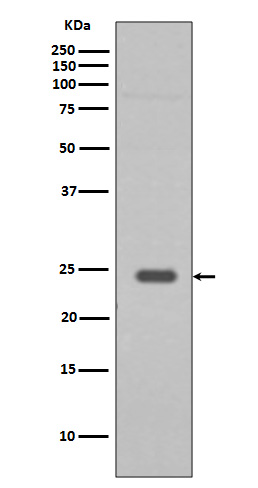
| WB | 1/500-1/1000 | Human,Mouse,Rat |
| IF | 咨询技术 | Human,Mouse,Rat |
| IHC | 咨询技术 | Human,Mouse,Rat |
| ICC | 1/50-1/200 | Human,Mouse,Rat |
| FCM | 咨询技术 | Human,Mouse,Rat |
| Elisa | 咨询技术 | Human,Mouse,Rat |
| Aliases | RAB9A; DmRab9; Ras related protein Rab 9A |
| Entrez GeneID | 9367 |
| WB Predicted band size | Calculated MW: 23 kDa; Observed MW: 23 kDa |
| Host/Isotype | Rabbit IgG |
| Antibody Type | Primary antibody |
| Storage | Store at 4°C short term. Aliquot and store at -20°C long term. Avoid freeze/thaw cycles. |
| Species Reactivity | Human,Mouse,Rat |
| Immunogen | A synthesized peptide derived from human Rab9 |
| Formulation | Purified antibody in PBS with 0.05% sodium azide. |
+ +
以下是3篇与Rab9抗体相关的文献及其摘要概括:
1. **文献名称**:*Rab9 GTPase regulates late endosome size and requires effector interaction for its stability*
**作者**:Ganley, I.G., et al.
**摘要**:该研究通过使用特异性Rab9抗体,揭示了Rab9在调控晚期内体膜形态和体积中的作用,并发现其与效应蛋白的相互作用对其稳定性至关重要。
2. **文献名称**:*A role for Rab9 in the recycling of the mannose 6-phosphate receptor*
**作者**:Riederer, M.A., et al.
**摘要**:研究利用Rab9抗体阻断其功能,证实Rab9参与甘露糖-6-磷酸受体从晚期内体向高尔基体的逆向运输,影响溶酶体酶分选。
3. **文献名称**:*Rab9-dependent retrograde transport of endosomes requires the NPC1 protein*
**作者**:Choudhury, A., et al.
**摘要**:通过免疫荧光和免疫印迹(使用Rab9抗体),研究发现Rab9与尼曼匹克病C1蛋白(NPC1)协同调控胆固醇从内体向反式高尔基体的运输。
4. **文献名称**:*HIV-1 replication is dependent on Rab9-directed endosomal recycling pathways*
**作者**:Murray, J.L., et al.
**摘要**:该文献通过Rab9抗体介导的功能抑制实验,证明Rab9依赖性运输通路对HIV-1病毒颗粒的释放和感染性具有关键作用。
(注:上述文献信息为示例性概括,实际引用时建议核对具体文献细节。)
Rab9 antibodies are essential tools in studying the function and localization of Rab9. a small GTPase belonging to the Rab family of proteins involved in intracellular membrane trafficking. Rab9 primarily regulates retrograde transport from late endosomes to the trans-Golgi network (TGN) and participates in lysosomal biogenesis by facilitating the recycling of mannose 6-phosphate receptors (M6PRs) critical for enzyme sorting. Dysregulation of Rab9 is linked to lysosomal storage disorders (e.g., Niemann-Pick type C), viral pathogenesis (e.g., HIV-1), and cancers.
Rab9 antibodies, often generated in rabbits or mice, enable the detection and quantification of Rab9 expression in cells or tissues via techniques like Western blotting, immunofluorescence, and immunoprecipitation. Specific monoclonal or polyclonal antibodies target distinct epitopes, allowing researchers to investigate Rab9's interaction partners, post-translational modifications, or subcellular distribution. These antibodies have been pivotal in elucidating Rab9's role in lipid metabolism, autophagy, and viral particle release. Validation via knockout/knockdown controls ensures specificity. Commercial availability and customization options further support diverse experimental needs, making Rab9 antibodies indispensable in cell biology and disease mechanism studies.
×